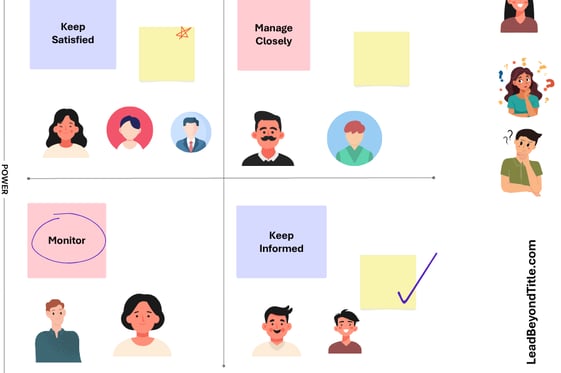Unlock Influence Early: Build Your Stakeholder Map


How Stakeholder Mapping Sets the Foundation for Confident Leadership
To lead effectively, you must understand who influences your team’s success—and how.
When you become a manager for the first time, it’s tempting to focus on tasks, tools, and targets. But leadership isn’t just about managing work — it’s about navigating people.
And for that, you need a map.
One of the most underused — but most powerful — tools in early-stage leadership is stakeholder mapping. It helps you understand the people dynamics around your role so you can build trust, gain alignment, and move with clarity.
Let’s explore how this simple strategy sets you up for lasting success.
Why Stakeholder Mapping Matters
Most new managers start strong with task lists and team meetings. But they often overlook one vital question:
Who really influences my success — directly and indirectly?
Your team’s performance is not isolated. It depends on your relationship with:
Your direct reports
Your manager
Peer leaders
Cross-functional collaborators
And yes… a few quiet voices you won’t find on the org chart
Stakeholder mapping helps you see the full picture and lead beyond your immediate circle.
Where to Begin: Stakeholder Identification
Start with your core players and work outward. For each key stakeholder, try to understand:
👉 Their expectations
👉 Their influence
👉 Their communication style
👉 How your team affects their outcomes
You’ll also want to identify the silent influencers — those individuals without formal authority who quietly shape culture, trust, or execution. These are the people who can help (or hinder) your leadership before you even realize it.
🎯 These quiet voices often Lead Beyond Their Title — and earning their trust is a leadership win.
Using the information that you have collected during your interactions, you may have already identified different stakeholders, now let us map them to visualise, plan and prioritise communication styles.
Visualize It: The Power–Interest Matrix
This tool helps you:
Spot key decision-makers early
Manage expectations proactively
Avoid overinvesting in the wrong places
Keep in mind — this map is fluid. People’s roles, influence, and engagement can shift. Revisit it quarterly to stay aligned with the evolving landscape.
💡 Pro tip: This map is a living document. Update it as relationships evolve and your influence grows.💡 Stakeholder awareness isn’t a “nice-to-have.” It’s a leadership multiplier.
Wrapping Up: Map to Lead, Not Just to Manage
Stakeholder mapping isn’t just a checkbox in your first 90 days—it’s your navigation system for leadership. It helps you:
Build trust faster
Avoid missteps, Friction
Communicate with intention
And most importantly—lead with clarity and connection
Remember, people drive progress. And the more clearly you understand who your stakeholders are and what matters to them, the more effectively you can align, influence, and deliver impact.
Leadership is about people, not just processes. And great managers know: influence often lies beyond the org chart.
So start with a map. Keep it active. Revisit it often.
And don’t forget—those “silent influencers” who shape your team’s success? They’re not always the loudest… but they’re often the most powerful allies. Many of them truly Lead Beyond Their Title. 😊


